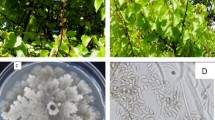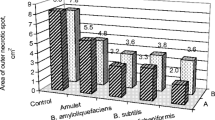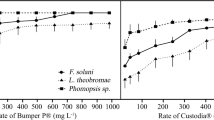Abstract
Black rot of pineapple caused by the fungus Chalara paradoxa is considered an aggressive and difficult disease to control. The use of natural products has been studied with the goal to incorporate them into integrated pest management and reduce the use of agrochemicals. Plant extracts have shown satisfactory results in controlling postharvest diseases by providing fungitoxic action and inducing plant resistance. The aim of this study was to evaluate C. paradoxa severity by the application of plant extract of Mormodica charantia, determinate effect of the plant extract on post-harvest quality, and induction of enzymes linked to host resistance induction. The following treatments were studied: plant extract of bitter melon at concentrations of 10, 100, 500 and 1000 ppm, the commercial products acibenzolar-S–Methyl and fungicide (thiabendazole) in the dosages recommended by the manufacturers, and distilled water as the control, with five replications and two plants per plot. The extract of M. charantia reduced the severity of black rot caused by C. paradoxa, compared to the control treatment, showing similar efficacy to the treatments with commercial inductor Acibenzolar-S-methyl and the fungicide. The enzymatic analysis showed increase of the peroxidase by the use of the bitter melon extract along the evaluation period. The enzymes polyphenol oxidase and phenylalanine ammonia lyase showed greater activity by treatment with M. charantia extract at 500 ppm. It was observed that the plant extract did not affect most of the variables analyzed related to postharvest quality of treated fruits. The use of the extract reduced the fruit weight loss, being a positive aspect under the studied conditions.


Similar content being viewed by others
References
Alfenas A.C., Mafia, R.G. (2007). Métodos em Fitopatologia. Viçosa MG. Universidade Federal de Viçosa. Ed UFV.
Andersen. P.P. (2012) A situação alimentar futuro do mundo e o papel das doenças de plantas. Internacional food policy reseacherch institute. Washington, dc aps. net. Página visitada em 13 de outubro de 2013, a partir de: http:///www.apsnet.org/publications/ apsnetfeatures/Pages/World.
AOAC - Association of Official Analytical Chemists. (1997). Official methods of analysis of AOAC international (16th ed.). Gaitheersburg: AOAC.
Blum, J., Hoffmann, F. B., Ayub, R. A., Jung, D. L., & Malgarim, M. B. (2008). Uso de cera na conservação pós-colheita do caqui cv. giombo. Revista Brasileira de Fruticultura, Jaboticabal, SP, 30(3), 830–833.
Bradford, M. M. (1976). A rapid and sensitive method for the quantification of microgram quantities of protein utilizing the principle of protein-dye binding. Analytical Biochemistry, 72, 248–254.
Brito, N.M. de, Neves, C.M.L., Veras, V., Nascimento, L.C. do, Souto, F.M., Araújo, E., Nery, A.R. (2005). Controle pós-colheita de Thielaviopsis paradoxa em abacaxizeiro. In: SBPCFT (Sociedade Brasileira para o progresso da Ciência), 1., João Pessoa. Anais. João Pessoa: Editora, 2005. 1 CD-ROM.
Carnelossi, P. R., Schwan-Estrada, K. R. F., Cruz, M. E. S., Itako, A. T., & Mesquini, R. M. (2009). Óleos essenciais no controle pós-colheita de Colletotrichum gloeosporioides em mamão. Revista Brasileira de Plantas Medicinais, Botucatu, 11(4), 399–406.
Castro, H. G., Oliveira, L. O., Barbosa, L. C. A., Ferreira, F. A., Silva, D. J. H., Mosquim, P. R., & Nascimento, E. A. (2004). Teor e composição do óleo essencial de cinco acessos de Mentrasto. Quimica Nova, 27, 55–57.
Celoto, M. I. B., Papa, M. F. S., Sacramento, L. V. S., & Celoto, F. J. (2011). Atividade antifúngica de extratos de Momordica charantia L. sobre. Colletotrichum musae Revista Brasileira de Plantas Medicinais, Botucatu, 13(3), 337–341.
Chakravarty, H. L. (1990). Cucurbits of India and their role in the development of vegetable crops. In D. M. Bates, R. W. RW Robinson, & C. Jeffrey (Eds.), Biology and utilization of Cucurbitaceae (pp. 325–334). Ithaca: Cornell University Press.
Chitarra, M. I. F., & Chitarra, A. B. (2005). Pós-colheita de frutos e hortaliças: fisiologia e manuseio (p. 785). Lavras: UFLA.
Costa. J.G.M., Nascimento, E.M.M., Campos, A.R.,Rodrigues, F.F.G. (2011). Antibacterial activity of Momordica charantia (Curcubitaceae) extracts and fractions. Journal of Basic and Clinical Pharmacy. Disponível em: www.jbclinpharm.com.
Cruz, M.E.S., Jardinetti, V.A., Ryche, A.G.G., Simon, J.M., Cruz, M.J.S. (2011). Efeito de Moringa oleifera na qualidade de frutos de manga CV Tommy Atkins. Cadernos de Agroecologia, Cruz Alta- RS, v. 6, n.2.
Faostat - Food and Agriculture Organization of the United Nations Statistical. Faostat Database Prodstat. Disponível em: <http://faostat.fao.org/faostat/servlet/>. Acesso em: 15 jan. 2012.
Faria, F.A., Bueno, C.J., Stradioto Papa, M.F. (2009). Atividade fungitóxica de Momordica charantia L. no controle de Sclerotium rolfsii Sacc. Acta Sciece., Agronomica. Maringá, v. 31, n. 3, July./Sept.
Ferrari, J. T. (2009). Divulgação Técnica, Podridão negra do abacaxi. Biológico, São Paulo, 71(1), 49–51.
Giron, L. M., Freire, V., Alonzo, A., & Caceres, A. (1991). Ethnobotanical survey of the medicinal flora used by the Caribs of Guatemala. Journal of Ethnopharmacology, 34, 173–187.
Gomes, E.C.S. (2011). Extrato de allamanda blanchetti na indução de fitoalexinas em sorgo e resistência em videira ‘superior seedless’ contra uncinula necator. Tese (Doutorado em Agronomia). UFPB Areia PB.
Grover, J. K., & Yadav, S. P. (2004). Pharmacological actions and potential uses of Momordica charantia: a review. Journal of Ethnopharmacology, 93, 123–132.
Gunders, D. (2012). Natural Resources Defense Council. Wasted: How America Is Losing Up to 40 Percent of Its Food from Farm to Fork to Landfill. BNRDC ISSUE PAPER. p.12-06.
Lans, C., & Brown, G. (1998). Observations on ethnoveterinary medicines in Trinidad and Tobago. Preventive Veterinary Medicine, 35, 125–142.
Lorenzi, H. (2000). Plantas daninhas do Brasil: terrestres, aquáticas, parasitas e tóxicas (3rd ed., p. 640). Nova Odessa: Istituto Plantarum.
Nakazawa, T., Komai, S., Tezuka, T., Hisatsune, C., Umemori, H., Semba, K., Mishina, M., Manabe, T., & Yamamoto, T. (2001). Characterization of Fyn-mediated tyrosine phosphorylation sites on GluR epsilon 2 (NR2B) subunit of the N-methyl-d-aspartate receptor. The Journal of Biological Chemistry, 276, 693–69.
PARA - Programa de Análise de Resíduos de Agrotóxicos em Alimentos. Relatório de Atividades de 2010. Brasília. Gerência Geral de Toxicologia. ANVISA, 2010.
Souza, M.L, Morgado, C.M.A., Marques, K.M., Mattiuz, C.F.M., Mattiuz, B. (2011). Pós-colheita de mangas ‘tommy atkins’ recobertas com quitosana. Revista Brasileira de Fruticultura, Jaboticabal, SP, vol. esp., Pp. 337–343.
Taiz, L., & Zeiger, E. (2009). Fisiologia vegetal (4th ed., p. 819). Porto Alegre: Artmed.
Tavella, L.B., Silva, Í.N.. Fontes, L.O., Dias, Jairo, R.M., Silva, M.I.L. (2011). AGROPECUÁRIA CIENTÍFICA NO SEMI-ÁRIDO (ACSA). O uso de agrotóxicos na agricultura e suas consequências toxicológicas e ambientais. Patos. v. 07, n 02. p. 06–12. 2011. Página visitada em 13 de abril de 2014, a partir de:< http: www.cstr.ufcg.edu.br. Acesso em: 05 ago.
Win, N. K. K., Jitareerat, P., Kanlayanarat, S., & Sangchote, S. (2007). Effects of cinnamon extract, chitosan coating, hot water treatment and their combinations on crown rot disease and quality of banana fruit. Postharvest Biology and Technology, 45(3), 333–340.
Xiao, Y. H., Li, X. B., Yang, X. Y., Luo, M., Hou, L., & Guo, S. H. (2007). Cloning and characterization of balsm pera class I chitinase gene (Mcchit 1) and its ectopic expressiong enhances fungal resistance in transgenic plants. Bioscience Biotechnology and Biochemistry, 71, 1211–1219.
Acknowledgments
The authors acknowledge the Conselho Nacional de Desenvolvimento Científico e Tecnológico (CNPq) for financial support made available for research and Laboratório de Biomassa CCA- UFPB by help us in experiments.
Author information
Authors and Affiliations
Corresponding author
Rights and permissions
About this article
Cite this article
de Souza, W.C.O., do Nascimento, L.C., Vieira, D.L. et al. Alternative control of Chalara paradoxa, causal agent of black rot of pineapple by plant extract of Mormodica charantia . Eur J Plant Pathol 142, 481–488 (2015). https://doi.org/10.1007/s10658-015-0627-6
Accepted:
Published:
Issue Date:
DOI: https://doi.org/10.1007/s10658-015-0627-6




